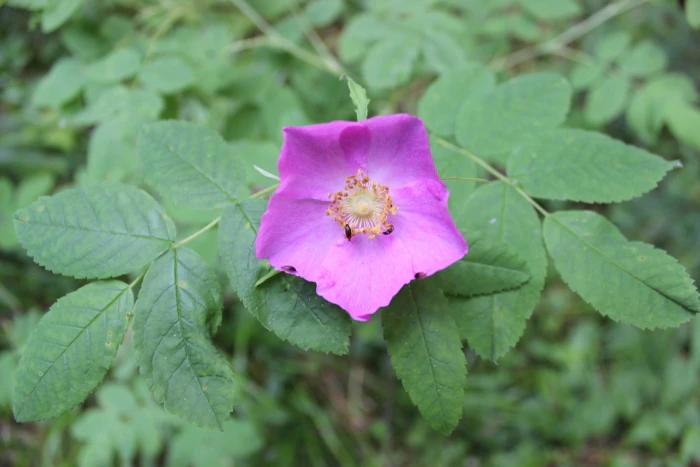Prickly Wild Rose
(Rosa acicularis)
Prickly Wild Rose (Rosa acicularis)
/
/

© Tatiana Strus
CC BY 4.0
Image By:
© Tatiana Strus
Recorded By:
Copyright:
CC BY 4.0
Copyright Notice:
Photo by: © Tatiana Strus | License Type: CC BY 4.0 | License URL: http://creativecommons.org/licenses/by/4.0/ | Uploader: tls-60 | Publisher: iNaturalist |





















Estimated Native Range
Climate Requirements for Elk River, Minnesota
| This Plant | Your Site | Plant Suitability for Your Location | ||
|---|---|---|---|---|
| • Precipitation | 2" - 86" | 30" | Your precipitation may be too high for this plant. | Too high |
| • High Temp. | 9°F - 93°F | 83°F | Your summer temperatures are normal for this plant. | Excellent |
| • Low Temp. | -56°F - 48°F | 1°F | Your winter temperatures are normal for this plant | Excellent |
This plant may not grow well at your location - your precipitation is too high.
Summary
Rosa acicularis, commonly known as the prickly wild rose, is a deciduous shrub native to a variety of habitats including boreal forests, forest edges, and riparian zones across northern regions of Asia, Europe, and North America. It typically grows to a height of 3-10 feet, with a similar spread, and is characterized by its stout, bristly stems and pinnate leaves. From late spring to early summer, it produces fragrant, showy pink flowers, followed by distinctive red, pear-shaped hips that persist into winter.
The prickly wild rose is valued for its hardiness and adaptability, often used in naturalistic plantings and as a wildlife-friendly addition to gardens. It provides food and habitat for pollinators and birds, and its hips are appreciated for their high vitamin A and C content. This species prefers full sun to partial shade and tolerates a range of soil types, though it thrives in moist, well-drained conditions. It is relatively low-maintenance but can be susceptible to common rose diseases such as black spot and powdery mildew. Rosa acicularis is the provincial flower of Alberta, Canada, and its leaves and inner bark have been traditionally used by Native Americans for tea, salad, and smoking tobacco.CC BY-SA 4.0
The prickly wild rose is valued for its hardiness and adaptability, often used in naturalistic plantings and as a wildlife-friendly addition to gardens. It provides food and habitat for pollinators and birds, and its hips are appreciated for their high vitamin A and C content. This species prefers full sun to partial shade and tolerates a range of soil types, though it thrives in moist, well-drained conditions. It is relatively low-maintenance but can be susceptible to common rose diseases such as black spot and powdery mildew. Rosa acicularis is the provincial flower of Alberta, Canada, and its leaves and inner bark have been traditionally used by Native Americans for tea, salad, and smoking tobacco.CC BY-SA 4.0
Plant Description
- Plant Type: Shrub
- Height: 3-7 feet
- Width: 4-6 feet
- Growth Rate: Rapid
- Flower Color: Pink
- Flowering Season: Spring, Summer
- Leaf Retention: Deciduous
Growth Requirements
- Sun: Full Sun, Part Shade
- Water: Medium
- Drainage: Fast, Medium, Slow
Common Uses
Bird Garden, Butterfly Garden, Fragrant, Groundcover, Showy Flowers
Natural Habitat
Boreal forests, forest edges, and riparian zones
Other Names
Common Names: Brandy Rose, Arctic Rose
Scientific Names: Rosa acicularis, Rosa acicularis var. fennica, Rosa acicularis var. glandulosa, Rosa acicularis var. typica, Rosa bourgeauana, Rosa cinnamomea var. dahurica
GBIF Accepted Name: Rosa acicularis